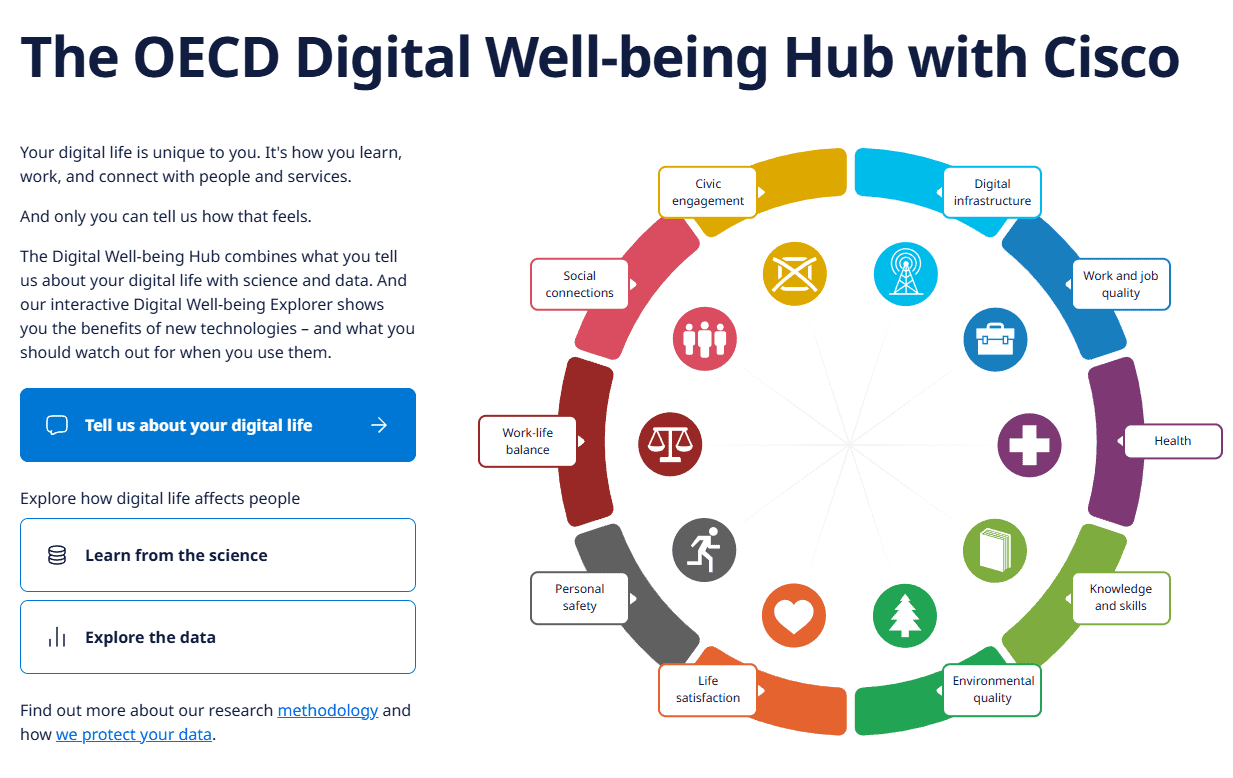Cisco and the Organization for Economic Cooperation and Development (OECD) want to shed more light on the relationship between digital technologies and personal well-being. The first step is the launch of a so-called Digital Well-being Hub. Not exactly a topic we often discuss in the world of technology. However, we found it interesting enough to want to learn more. We discussed it with Guy Diedrich of Cisco.
The relationship between digital technologies and personal well-being may sound a bit esoteric. More something you would expect to find on the pages of a glossy magazine. However, in our opinion, that is not justified. Correlations and possible causal connections between the two components are indeed important to gain insight into. The digital component of our lives is constantly growing, so it is logical that it has an impact on our personal lives. This applies to business environments, but also to private environments.
From Digital Readiness Index…
Cisco has been conducting research into the state of digitization for many years. This Digital Readiness Index was and is mainly designed to expose gaps, for example in the area of connectivity. Partly due to this type of research, it became clear that 30 percent of the world is not yet connected. Based on this, it is then possible to take steps to change this, for example through Cisco’s Country Digital Acceleration Program (CDA), but also through initiatives like Starlink.
The above insights will still be relevant in 2025. There will only be more products and services that require a network connection. The prediction is that there will be around 500 billion by 2030. However, after about ten years, Cisco wanted to take the next step, Diedrich explains. He is SVP and Global Innovation Officer at Cisco and in that role he is responsible for the CDA program, among other things.
…to Digital Well-being Hub
The next step Diedrich alludes to in our conversation is the Digital Well-being Hub, a joint initiative of the OECD and Cisco. The Organization for Economic Cooperation and Development is an organization with 38 member countries. The aim of this organization is to stimulate economic progress, but also the social well-being of people. At least that is what the organization says on its website. The 38 countries are almost exclusively Western countries, supplemented by Japan, Australia, New Zealand and a few countries from Latin America, but there are collaborations with more than 100 countries in the world to achieve the organization’s objectives.
For Diedrich, the Digital Well-being Hub is a very important initiative. “We do not know the impact of digitization, for example, with regard to AI and many other technologies,” he says. A considerable number of theoretical studies have been conducted, including a lot of research from the OECD. “However, no one has ever conducted research among actual citizens, the users of the technology,” he continues. We know the benefits of technology, but there are also harmful aspects. Especially when there is a lack of knowledge and skills. The latter is ultimately what the Digital Well-being Hub is all about: it must provide the input to do something about those harmful aspects.
Cisco means business with the Digital Well-being Hub
Understanding the impact of digitization on people’s environment is very important for one of the basic objectives of the CDA program. CDA wants to help achieve a “sustainable, safe and inclusive digital future for everyone”, according to Cisco. “It is not possible to achieve this without this input,” Diedrich believes.
Diedrich also emphasizes once again that Cisco is very involved: “We helped pull together the project, helped fund it, helped create the questions and used our huge ecosystem to attract people to this project.” He believes it takes a company of Cisco’s size and footprint to help make a project like the Digital Well-being Hub possible. He might very well be correct in this belief, as it is a big undertaking.
The goal of the Digital Well-being Hub is to collect data that actually adds something, from which Cisco itself can also learn something. “The data should help inform us on where we take CDA. It also helps us with our customers around the world,” Diedrich indicates. Mind you, the Digital Well-being Hub does not provide ready-made causal connections and therefore advice on how to deal with something. It is up to the market and OECD partners to do something with it, as Cisco itself intends to do.
Crowdsourcing as a new method
You can see the Digital Well-being Hub as a worldwide crowdsourcing platform. Participation is not complicated and does not take more than ten minutes. It is a questionnaire like the ones we often encounter in surveys. It is all multiple choice and mainly revolves around how the respondent experiences something. So the questions all have answers on a scale. These can be numbers, but also levels of satisfaction, happiness, things like that.

The questions are further divided into multiple categories, always with a link to the digital world. There are questions that generally deal with how happy someone feels, the work-life balance, personal safety, but also the quality of the environment, knowledge and skills, health and of course the digital infrastructure and the impact of technology on social patterns. At the end, you will see an overview of how you score in relation to the average in your region.
Using Cisco’s breadth and depth
“Reaching out directly to users is a new way of doing things,” Diedrich explains. So it remains to be seen what the Digital Well-being Hub will yield for Cisco and the OECD. With Cisco’s enormous reach, for example through NetAcademy, it should at least be possible to collect data from all corners of the world. NetAcademy is active in almost every country in the world, while the OECD only has 38 members. In some countries, it may not be many people, but a little data is still better than no data at all. Cisco could make it a fixed component of participation in NetAcademy, for example. Then it could really take off.
Something really must be done, is the undertone in Diedrich’s argument, who has a background as a researcher in the academic world. “If we do nothing, the digital divide will only increase,” he says. “The connected few are going to take off to the stratosphere, the 30 percent that aren’t connected won’t be able to keep up.” When you consider that even in OECD countries, no less than forty percent of adults have no or insufficient digital skills, it is certainly not a bad idea to give this much more attention than we have done so far.
It is never finished
With the Digital Well-being Hub, Cisco and the OECD have started something that really has no end date. “It will never be finished,” Diedrich says when we make this observation during our conversation. However, the two parties together have a very interesting view of the world, he says: “We are able to understand the pace of technological change and have never seen innovation going faster.” He calls it “a Moore’s Law for the entire industry”. This makes it even more important to keep skills up to date, especially if not doing so means that people will experience a decline in all areas of their lives.
The Digital Well-being Hub as it is now will undoubtedly change as well. Diedrich believes that the most important thing is that this initiative is an attempt to set up a kind of scale to weigh positive and negative effects. That is very important to get a clear picture.
Much more to come
Diedrich also makes a promise towards the end of our conversation: “This partnership is just the beginning.” He draws a parallel with the AI-Enabled ICT Workforce Consortium, which Cisco co-founded last year. In it, it collaborates with players such as Accenture, Google and Microsoft. A first result is a document with concrete tips on the subject.
A somewhat older example of how you can also see the Digital Well-being Hub is SEMATECH. This American consortium was set up to be able to stand up to the Japanese chip industry. To be able to do this, a lot of fundamental and sometimes basic research had to be done first. Only once that had been done could they begin to compete. Over time, SEMATECH became virtually irrelevant and has since ceased to exist. It had achieved its goal.
Cisco and the OECD are now conducting this fundamental research for the Digital Well-being Hub. This is not about gaining a competitive advantage, but about shaping the entire industry and digital world for the better, Diedrich claims. He expresses the hope that this will ultimately lead to an industry standard for digital well-being.
“The most important conversation to have”
A conversation about the concept of digital well-being and the Digital Well-being Hub that Cisco and the OECD have set up together is a new kind of conversation. For us, but undoubtedly for many others as well. In other words, it is a different conversation than the one we generally have about technology. “However, it could just be the most important topic we need to talk about with regard to technology,” Diedrich concludes. Cisco is clearly participating in the conversation.
What will ultimately become of the Digital Well-being Hub remains to be seen, of course. We will only be able to assess the results after some time has passed and action has been taken based on insights gained from the data. However, it is good to see that a company of Cisco’s size and stature is willing to get involved. Without such players, it is very difficult, if not impossible, to carry out the fundamental research for the initiative effectively.
Also read: Not all XDR platforms are created equal: quality telemetry is critical

